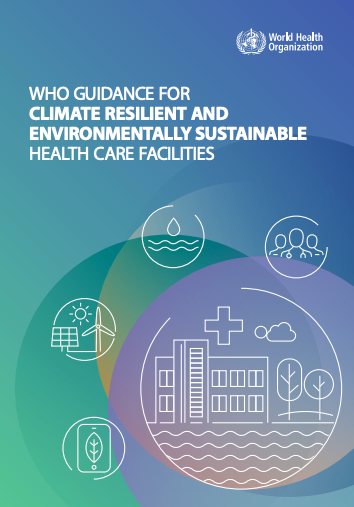WHO Guidance for Climate Resilient and Environmentally Sustainable Health Care Facilities
Organization: World Health Organization (WHO)
Year: 2020

The aim of this guidance is to enhance the capacity of health care facilities to protect and improve the health of their target communities in an unstable and changing climate; and to empower health care facilities to be environmentally sustainable, by optimizing the use of resources and minimizing the release of waste into the environment. Climate resilient and environmentally sustainable health care facilities contribute to high quality of care and accessibility of services, and by helping reduce facility costs also ensure better affordability. They are, therefore, an important component of universal health coverage (UHC).
This document aims to:
- Guide professionals working in health care settings to understand and effectively prepare for the additional health risks posed by climate change.
- Monitor, anticipate, manage and adapt to the health risks associated with climate change.
- Guide health care facility officials to work with health determining sectors (including water and sanitation, energy, transportation, food, urban planning, environment) to prepare for additional health risks posed by climate change through a resilience approach, and to promote environmentally sustainable practices in providing these services.
- Provide tools to assist health care facility officials assess their resilience to climate change threats, and their environmental sustainability based upon the appropriate use of resources (in particular water and energy and sustainable procurement), and release of hazards (biological, chemical, radiological), to their surrounding environment.
- Promote actions to ensure that health care facilities are constantly and increasingly strengthened and continue to be efficient and responsive to improve health and contribute to reducing inequities and vulnerability within their local settings.
This guidance document provides a set of suggested interventions, along the lines of four fundamental requirements for providing safe and quality care in the context of climate change: (1) the health workforce; (2) water, sanitation, hygiene and health care waste management; (3) sustainable energy services; and (4) Infrastructure, technologies and products.
Chapter 1 discusses the public health rationale, and the investment case for climate resilient and environmentally sustainable health care facilities. Chapter 2 provides the policy context and background information on the baseline or essential requirements for health care facilities to be able to provide safe and quality health care, upon which resilience and environmental sustainability should be built. Chapter 3 introduces key concepts, the goals, objectives and proposed framework for the implementation of interventions aiming to strengthen climate resilience and environmental sustainability. Chapter 4 provides proposed interventions, organized into 24 tables around the four broad areas of the framework.